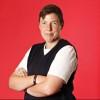Earlier this summer I was stoked to keynote the Graphic Medicine conference whose theme this year was Que(e)rying Graphic Medicine. My talk was called 'queer, mad comics'. Graphic Medicine have recently published a podcast of the talk, along with some of the images I used in the presentation, over on their website. This post contains a summary of the talk and some of the comics that I used in the presentation.
I'd heard of the Graphic Medicine conference before but had assumed that the 'medicine' in the title meant that it was mainly for doctors, nurses and other medical types. Actually the event - and the community around it - are for anybody who works at the intersection of comics and health of any kind. So there were many creators there who use graphic memoir or comics to depict their experiences with disabilities or physical and/or mental health struggles. There were also academics, activists, and practitioners who are interested in creating comics and zines to raise awareness of particular issues, or in analysing work which is already out there on these themes. I met some incredible people and saw some powerful presentations. I'd encourage you to check out their website and follow them on social media to find out more.
The conference organisers invited me because they were familiar with my book Queer: A Graphic History. Like me, I think they got more than they bargained for because they hadn't realised that I've also created comics and zines to explore mental health struggles: both from a personal exploration perspective, and to raise awareness or give others tools to do this kind of work.
I'll give a brief overview of the talk here. You can check out the full podcast if you want to hear the more detailed version. I've also been writing more lately on plural selves in relation to queerness, mental health, and comics, which I'll be sharing here soon.
My history with comics
I started the talk by reflecting on my own history with comics and how this was interwoven with gender, sexuality, and mental health. In childhood comics were a place of safety to retreat to alone when outer relationships became traumatic.
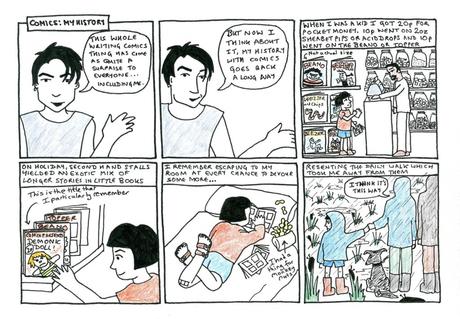 My history with comics: Early days
My history with comics: Early days Girls comics were one of the key places where I learnt very gendered scripts about how to perform femininity, at the same time as being a place of some resistance to this as I followed my love of horror comics.
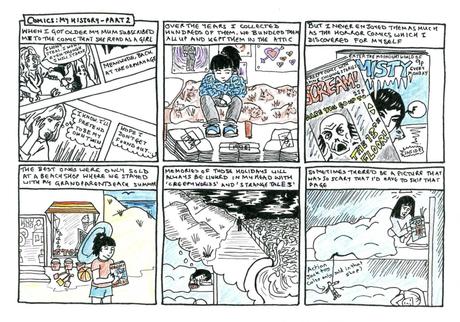 My history with comics: Gender
My history with comics: Gender When I discovered graphic novels this rekindled my passion for comics, and they became a place where I learnt about queerer ways of doing gender, sexuality, and relationships, as well as a sanctuary during tough mental health times.
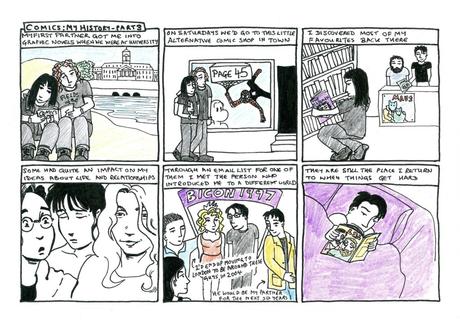 My history with comics: Graphic novels
My history with comics: Graphic novels I reflected how, these days, my favourite genre of comics is memoir, particularly queer and mental health graphic memoirs. It's interesting how many graphic memoir authors focus on stories of queerness or mental health, and how often these overlap. Many mental health comics also depict people and relationships which are queer in some way, and many queer comics also cover mental health struggles, perhaps understandably given the extent of trauma inevitably involved in growing up queer in a heteronormative world. More on queer comics here.
Using comics in my work
In the presentation I spoke a bit about how I've incorporated my own comics into book projects like Rewriting the Rules and Mindful Counselling and Psychotherapy. Largely this was out of necessity because there was no money available to pay illustrators. For the mindfulness book it also felt important to include something which got across the lived experience of mindful meditation - which is very different to the shiny panacea offered by many advocates of mindfulness. Comics can often be a more powerful, visceral, way of depicting lived experience than words or pictures alone.
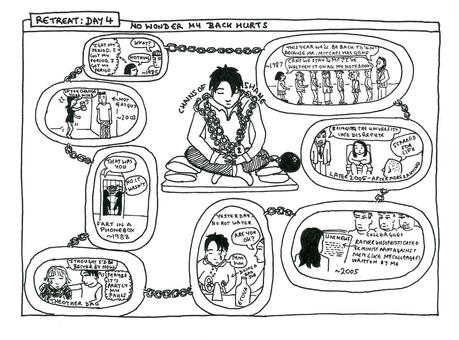 Mindfulness comic
Mindfulness comic Importantly these comics also depict the link between cultural scripts of gender and sexuality and mental health struggles as a biopsychosocial experience.
Queer, gender and sexuality
In the talk I gave a brief introduction to queer thinking based on Queer: A Graphic History. I explained how queer theory and queer activism emphasise that our lived experience occurs within a historical and social context. We're massively shaped by cultural messages around who is more or less normal, and social structures that uphold this. We can't disentangle our lived experience from wider culture.
Also queer thinking points out that our identities are not fixed or singular but fluid and plural, in terms of sexuality and gender but also more widely than this.
I spoke a bit about projects where I've used comics and zines to help people to explore these kinds of ideas in relation to gender and sexuality, in the form of workbooks. Jules Scheele and I also have new graphic guides coming on the themes of gender (2019) and sexuality (2020). Jules also included my first published comic in this zine on performance.
Mental health
Back in 2015, Caroline Walters, Joseph de Lappe and I put together a special issue of Asylum magazine on comics and mental health. Our call for submissions prompted so much interest that we ended up taking over four issues of the magazine with comics. Many people found that reading and/or creating comics was very helpful in relation to their own mental health, and to surviving toxic wider cultures, and mental health institutions. You can read more of my thoughts on this in this article I did for The Psychologist.
 Depression
Depression A big part of my work now involves making comics and zines relating to mental health. These take the following overlapping forms:
From a queer perspective most of this work/play makes explicit links between wider cultural normativity and mental health struggles. It also often plays with the queer theme of identity as fluid and plural. Many of my comics involve time-travelling back to communicate with earlier versions of myself, or shape-shifting between different sides of myself in order to bring them into communication. I've written on here before about trans and queer people as time-travellers and shape-shifters, and what can be gained from these ideas for everyone.
After the conference I was invited to submit a paper to a special issue of the Journal of Graphic Novels and Comics on sexuality and mental health. Hilariously having just left academia and vowed to write no more academic papers here was an invitation I couldn't refuse, and I think it's one of the best academic articles I've ever written! I focused on plurality and how this relates to gender, sexuality and mental health, as well as this theme of how comics can help us to explore plurality via time travel and shapeshifting. More on all of that soon...
If you enjoyed this, listen to the whole talk here.
